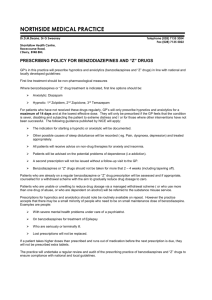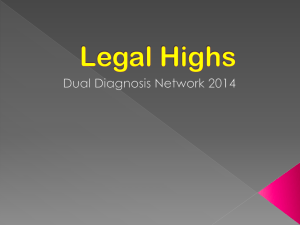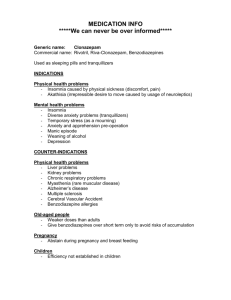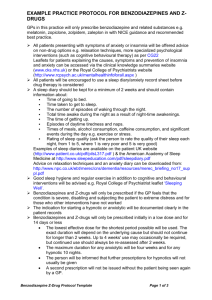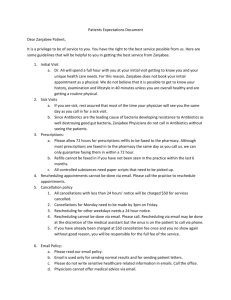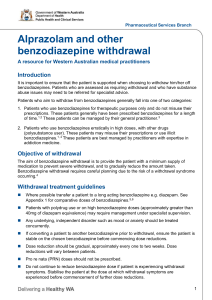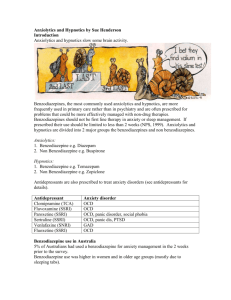BONDORMIN
advertisement
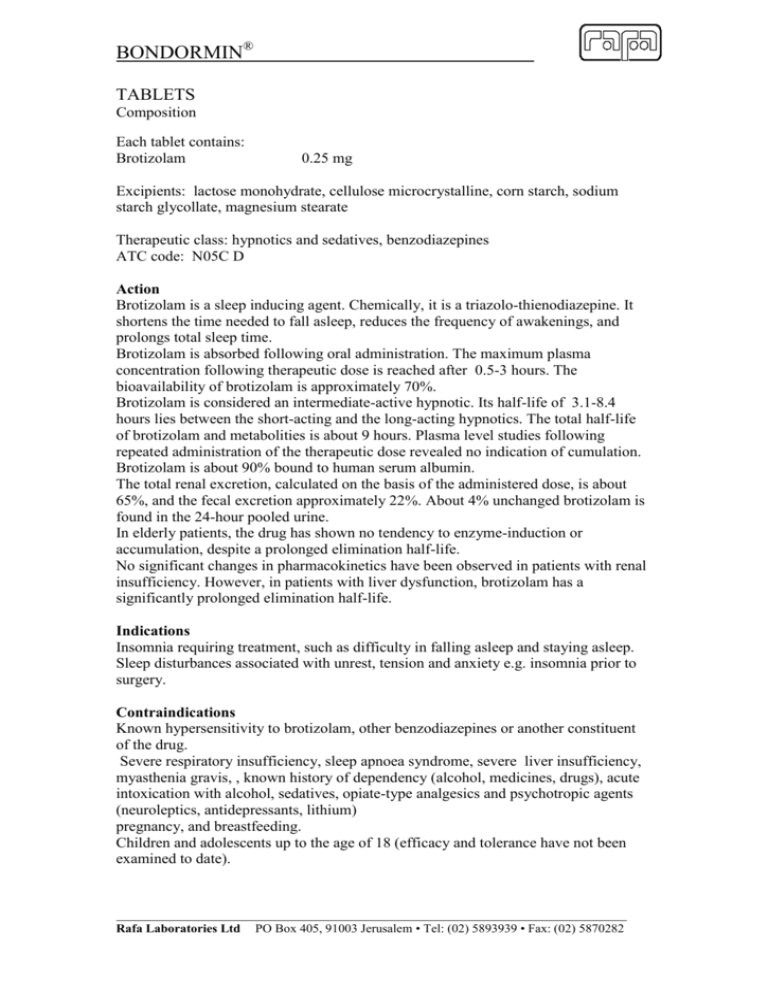
BONDORMIN® TABLETS Composition Each tablet contains: Brotizolam 0.25 mg Excipients: lactose monohydrate, cellulose microcrystalline, corn starch, sodium starch glycollate, magnesium stearate Therapeutic class: hypnotics and sedatives, benzodiazepines ATC code: N05C D Action Brotizolam is a sleep inducing agent. Chemically, it is a triazolo-thienodiazepine. It shortens the time needed to fall asleep, reduces the frequency of awakenings, and prolongs total sleep time. Brotizolam is absorbed following oral administration. The maximum plasma concentration following therapeutic dose is reached after 0.5-3 hours. The bioavailability of brotizolam is approximately 70%. Brotizolam is considered an intermediate-active hypnotic. Its half-life of 3.1-8.4 hours lies between the short-acting and the long-acting hypnotics. The total half-life of brotizolam and metabolities is about 9 hours. Plasma level studies following repeated administration of the therapeutic dose revealed no indication of cumulation. Brotizolam is about 90% bound to human serum albumin. The total renal excretion, calculated on the basis of the administered dose, is about 65%, and the fecal excretion approximately 22%. About 4% unchanged brotizolam is found in the 24-hour pooled urine. In elderly patients, the drug has shown no tendency to enzyme-induction or accumulation, despite a prolonged elimination half-life. No significant changes in pharmacokinetics have been observed in patients with renal insufficiency. However, in patients with liver dysfunction, brotizolam has a significantly prolonged elimination half-life. Indications Insomnia requiring treatment, such as difficulty in falling asleep and staying asleep. Sleep disturbances associated with unrest, tension and anxiety e.g. insomnia prior to surgery. Contraindications Known hypersensitivity to brotizolam, other benzodiazepines or another constituent of the drug. Severe respiratory insufficiency, sleep apnoea syndrome, severe liver insufficiency, myasthenia gravis, , known history of dependency (alcohol, medicines, drugs), acute intoxication with alcohol, sedatives, opiate-type analgesics and psychotropic agents (neuroleptics, antidepressants, lithium) pregnancy, and breastfeeding. Children and adolescents up to the age of 18 (efficacy and tolerance have not been examined to date). Rafa Laboratories Ltd PO Box 405, 91003 Jerusalem • Tel: (02) 5893939 • Fax: (02) 5870282 BONDORMIN® Warnings Tachyphylaxis The ingestion of benzodiazepines or benzodiazepine-like substances over a few weeks can lead to a reduction in efficacy (tachyphylaxis). Dependence Bondormin, like other hypnotic agents, should not be employed over long periods to treat insomnia. Treatment should not exceed several weeks, except in justifiable cases. Prolonged use may cause dependence. The risk of dependence is greater in patients with a history of alcohol or drug abuse. Withdrawal Withdrawal symptoms similar in character to those noted with barbiturates and alcohol have occurred following abrupt discontinuation of benzodiazepine drugs. These symptoms include convulsions, tremor, abdominal and muscle cramps, vomiting and sweating. Withdrawal should be effected by a gradual reduction in dosage. In some patients, withdrawal of brotizolam leads to a degree of rebound insomnia on the first night without treatment. The symptoms are usually not severe. Paradoxical reactions such as acute hyperexcited states, anxiety, hallucinations, increased muscle spasticity, rage, insomnia, sleep disturbances and stimulation have been reported. Should these occur, use of the drug should be discontinued. Dosage adjustment is required in patients with liver dysfunction. Bondormin is not recommended for use as a tranquilizer. Amnesia Benzodiazepines and benzodiazepine-like substances can cause anterograde amnesia. This means that the patient is subsequently no longer able to remember actions, for example, which he/she performed after taking the medication. This risk increases, the higher the dose, usually occurs within a few hours of intake and can be reduced by allowing for sufficiently long, uninterrupted sleep (7 – 8 hours). Mental and "paradoxical" reactions The use of benzodiazepines can cause mental and paradoxical reactions, particularly in elderly patients or children . In such cases, treatment with Bondormin should be discontinued. Use in Pregnancy Benzodiazepines have the potential to cause fetal harm when administrated to pregnant women. If this drug is used during pregnancy or the patient becomes pregnant while taking this drug, she should be informed of the potential hazard to the fetus. Benzodiazepines are assumed to be capable of causing an increased risk of congenital abnormalities when administrated to pregnant women during the first trimester. Since use of these drugs is rarely a matter of urgency, their use during the pregnancy should be avoided (see Contraindications). Rafa Laboratories Ltd PO Box 405, 91003 Jerusalem • Tel: (02) 5893939 • Fax: (02) 5870282 BONDORMIN® If brotizolam has to be administered in high doses during late pregnancy or during labour, effects such as respiratory insufficiency, hypothermia, muscular hypotonia and floppy infant syndrome can be expected in the neonate. The possibility that women of child-bearing potential may be pregnant when therapy is instituted should be considered. Patients should be advised that if they become pregnant during therapy or intend to become pregnant, they should refer to their physician about the desirability of discontinuing the drug. Use in Breastfeeding Benzodiazepines are excreted in breast milk. Since neonates metabolize this drug more slowly than adults, and accumulation of the drug and its metabolites to toxic levels is possible, it should not be administered to nursing women (see Contraindications) Use in Pediatrics No studies on the use of brotizolam in children have been conducted. The available dosage form of Bondomin is only suitable for administration to adults. Bondormin is therefore not recommended for use in children. Effects on ability to drive and use machines Sedation, amnesia, impaired concentration and functional muscle disturbances can affect the ability to drive or use machines. This is particularly true in combination with alcohol and central depressant drugs (see "interactions") and if sleeping time is insufficient. Adverse Reactions Adverse reactions with different benzodiazepines vary in type and frequency. Some are dose-related, while others involve individual patient sensitivity. Although not all of the following adverse reactions have been attributed specifically to each benzodiazepine drug, the potential for their occurrence exists. This should be borne in mind when drugs of this class are administered. The most-commonly reported side effects have been drowsiness, fatigue and ataxia, especially in elderly or debilitated patients. These effects may be lessened by a reduction in dosage. Infrequently reported side effects are listed below. Central Nervous System Sedation and sleepiness, depression, lethargy, apathy, hypoactivity, lightheadedness, disorientation, restlessness, confusion, delirium, headache, slurred speech, dysarthria, syncope, vertigo, tinnitus, dizziness, nervousness, vivid dreams, psychomotor retardation. Reduced vigilance, ataxia, enterograde amnesia, possibly associated with inappropriate behavior Gastrointestinal Constipation, diarrhea, dry mouth, nausea, vomiting, increased salivation. Genitourinary Incontinence, dysuria, enuresis, changes in libido, urinary retention, menstrual irregularities. Rafa Laboratories Ltd PO Box 405, 91003 Jerusalem • Tel: (02) 5893939 • Fax: (02) 5870282 BONDORMIN® Cardiovascular Bradycardia, tachycardia, hypertension, hypotension, palpitations. Opthalmological Visual disturbances, diplopia Dermatological Urticaria, pruritus, skin rash, dermatitis. Musculoskeletal and connective tissue disorders: Rare: weak muscles General disorders: Hepatic dysfunction (including hepatitis and jaundice), blood dyscrasias including agranulocytosis, anemia, thrombocytopenia, eosinophilia. drowsiness, paradoxical reactions (eg restlessness, excitement, irritability) and withdrawal and rebound reactions such as rebound insomnia (insomnia after withdrawal) In view of the muscle-relaxant effect of brotizolam, due caution is called for in elderly patients (risk of falling). Cases of benzodiazepine abuse have been reported. Withdrawal symptoms Withdrawal and rebound reactions may be a warning sign indicating the development of dependence. If a patient has become physically dependent, sudden discontinuation can induce withdrawal symptoms such as headache, muscle ache, serious panic attacks, tension, restlessness, confusion or irritability. The following symptoms can occur in severe cases: loss of touch with reality, change in personality, hyperacusis, numbness and tingling in the extremities, hypersensitivity to light, noise and physical contact, hallucinations, or epileptic attacks. Mental and "paradoxical" reactions Reactions such as restlessness, excitement, irritability, aggressiveness, delusions, anger, vivid nightmares, hallucinations, psychosis and behavioural disorders have been reported following use of benzodiazepines and benzodiazepine-like substances. The product should be discontinued if such reactions develop. These symptoms are particularly common in children and elderly patients. Precautions In elderly or debilitated patients, the initial dose should be low. Dosage increments should be made gradually, according to the response of the patient, in order to preclude ataxia or excessive sedation. Although hypotension has rarely occurred, the drug should be administered with caution to patients in whom a drop in blood pressure might lead to cardiac complications. Caution should be exercised in patients with impaired renal or hepatic function, and in patients with chronic pulmonary insufficiency. Patients who experience drowsiness during treatment should be warned that their ability to perform potentially hazardous tasks requiring mental alertness or physical coordination, such as driving a vehicle or operating machinery, may be impaired. Similarly, children should be warned not to participate in activities such as riding a bicycle or playing near traffic. Rafa Laboratories Ltd PO Box 405, 91003 Jerusalem • Tel: (02) 5893939 • Fax: (02) 5870282 BONDORMIN® Patients with rare hereditary problems of galactose intolerance, the Lapp lactase deficiency or glucose-galactose malabsorption should not take Bondormin. Administration of brotizolam alone is not recommended for the management of psychotic diseases. Benzodiazepines and benzodiazepine-like substances should not be used alone for the treatment of depression or panic attacks associated with depression as this can increase the risk of patients becoming suicidal. Depressive symptoms can be potentiated in depressive patients. Treatment should be discontinued if necessary in such cases. Drug Interactions Benzodiazepines may have a potentiating effect on centrally-acting drugs such as neuroleptics, tranquilizers, antidepressants, hypnotics, anxiolytics/sedatives, narcoanalgetics, narcotics, antiepileptics, sedative antihistamines, analgesics and anesthetics. When these drugs are administered concomitantly with benzodiazepines, their dosage should be reduced. Combination with narcoanalgesics can potentiate the euphoric effect and thus accelerate the development of dependence. Benzodiazepines may also intensify the response to alcohol. Patients should avoid drinking alcohol while under treatment with this drug. As the nature and extent of interactions with other drugs (antidiabetics, antihypertensives, cardiac glycosides and hormones) cannot be predicted reliably in each individual case, due caution is called for when prescribing Bondormin to patients on these drugs. Concomitant administration of muscle relaxants can potentiate the muscle-relaxant effect. Brotizolam is metabolized chiefly by the cytochrome P450 isoenzyme CYP 3A4 in the liver. Drugs that compete with the substance for CYP 3A4 (competitive inhibition) and drugs that inhibit CYP 3A4 can potentiate the effect of brotizolam. Know substrates for CYP 3A4 include: astemizole, azole-antimycotics (eg itraconazole, ketoconazole), immunosuppressants (eg cyclosporin A, sirolimus, tacrolimus), calcium antagonists, macrolide antibiotics (eg clarithromycin, erythromycin), antimalarial drugs (eg halofantrine, mefloquine), midazolam, pimocide, protease inhibitors (eg indinavir, nelfinavir, ritonavir), sildenafil, statins (eg atorvastatin, lovastatin, simvastatin), steroids (eg ethinylestradiol), tamoxifen, terfenadine. Inhibitors of CYP 3A4 include: azole-antimycotics, cimetidine, grapefruit juice, macrolide antibiotics, protease inhibitors. Drugs that potentiate the enzyme activity of CYP 3A4 can weaken the effect of brotizolam (eg carbamazepine, efavirenz, St John’s wort, nevirapine, phenobarbitol, phenytoin, primidone, rifabutin, rifampicin.) Dosage and Administration The usual dose is 1 tablet. In isolated cases (e.g. pre-operative sleep disturbances) the dose may be increased to 2 tablets. ½ a tablet is recommended for elderly patients, and for those patients in whom clearance is decreased. The tablets may be swallowed whole with half a glass of liquid. The tablet should not be taken on a full stomach in order to avoid impairing the onset and duration of action. The tablet can also be dissolved slowly under the tongue before bedtime. Sufficient time for sleep must also be guaranteed to reduce the risk of affecting Rafa Laboratories Ltd PO Box 405, 91003 Jerusalem • Tel: (02) 5893939 • Fax: (02) 5870282 BONDORMIN® reactions (ability to drive) the next morning. Patients should allow for 7-8 hours sleep after taking the tablet. The treatment period should be kept to a minimum. Generally, treatment should be continued for a few days but no more than 2 weeks. Discontinuation of the medication should be gradual and tailored to the individual patient. It should be borne in mind that there may be an initial recurrence of the sleep disturbances as a result of discontinuing the medicine, in rare cases this may also be accompanied by restlessness and tension. In exceptional cases, treatment may have to be continued for more than 2 weeks; however, the patient's condition should first be re-examined before continuing. Overdosage As with other benzodiazepines , an overdose is generally unlikely to be lifethreatening provided this is not combined with other central depressants (including alcohol). When treating an overdose with medicinal products, it must be borne in mind that the patient may have taken several substances. Symptoms of overdose An overdose of benzodiazepines is usually manifest in central depressant reactions of varying intensity. Milder cases may include symptoms such as drowsiness, confusion and lethargy, in more severe cases there may be ataxia, arterial hypotension,respiratory depression, in rare cases coma; death is possible in extremely rare cases. Treatment of overdose Treatment focuses primarily on symptomatic measures. If the patient is conscious, vomiting should be induced (within one our) either mechanically or with emetics as long as the patient is still conscious.. If the patient is unconscious, gastric lavage utilizing a cuffed endotracheal tube to prevent aspiration and pulmonary complications should be employed. General supportive measures should be employed along with intravenous fluids. An adequate airway should be maintained. If gastric emptying is of no use, active charcoal should be given to reduce absorption. Vital functions in particular (breathing, cardiovascular function)s hould be monitored, if necessary in intensive care. Hypotension may be combated by the administration of noradrenaline or metaraminol. If excitation occurs, barbiturates should not be used. Flumazenil, as specific benzodiazepine-antagonist, can be used as an antidote if required. Flumazenil product information should be consulted prior to use. In view of the large distribution volume and the pronounced plasma-protein binding, forced dieresis or haemodialysis are likely to be of little benefit in the event of pure brotizolam intoxication. Presentation: 10 tablets Storage: Store below 25ºC Manufacturer: Rafa Laboratories Ltd PO Box 405, 91003 Jerusalem The format and content of this document have been approved by the Ministry of Health in October 2010 Rafa Laboratories Ltd PO Box 405, 91003 Jerusalem • Tel: (02) 5893939 • Fax: (02) 5870282
